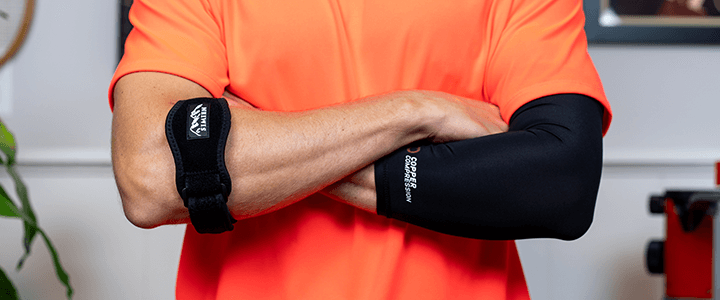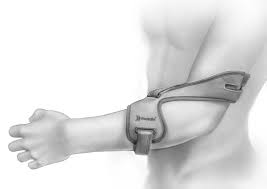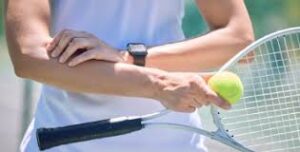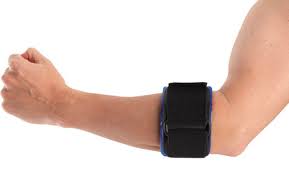5 Best Tennis Elbow Medical Devices: Tennis Elbow Splint

There are many different types of tennis elbow medical devices and other orthotic devices available for treating a tennis elbow.
Tennis Elbow Medical Devices
Tennis elbow, also known as lateral epicondylitis, is a condition characterized by pain and inflammation in the tendons of the forearm muscles near the elbow. Several medical devices can be used to aid in the treatment and management of tennis elbow. Here are some examples:
- Counterforce Brace: A counterforce brace is a strap or band worn around the forearm just below the elbow. It applies pressure to the tendon and muscles, helping to alleviate pain and provide support during activities that may aggravate the tennis elbow.
- Elbow Strap: An elbow strap is a compression device that applies targeted pressure to the affected tendon. It helps to relieve pain and reduce stress on the tendon during movement.
- Elbow Sleeve: An elbow sleeve is a flexible garment made of neoprene or other materials. It provides compression, warmth, and support to the elbow joint, promoting blood flow and reducing pain and inflammation.
- Cold Compression Therapy: Cold compression therapy devices combine cold therapy with compression. These devices typically consist of a wrap or sleeve that can be filled with ice or gel packs. They help reduce the pain, swelling, and inflammation associated with tennis elbow.
- Therapeutic Ultrasound Device: Therapeutic ultrasound devices use high-frequency sound waves to stimulate deep tissues and promote healing. They can be used to target the affected area and reduce pain, inflammation, and muscle tension associated with tennis elbow.
- Electrotherapy Devices: Electrical stimulation devices, such as transcutaneous electrical nerve stimulation (TENS) units, can provide pain relief by delivering low-level electrical currents to the affected area. These devices help to reduce pain perception and promote healing.
Lateral epicondylitis, commonly known as tennis elbow, is a condition characterized by pain and inflammation on the outer side of the elbow. It is caused by repetitive or overuse of the forearm muscles, leading to strain and micro-tears in the tendons that attach to the lateral epicondyle, a bony prominence on the outside of the elbow.
Activities that involve repetitive wrist extension and gripping motions, such as playing tennis, golfing, typing, or using tools, can contribute to the development of lateral epicondylitis. However, it can also occur due to non-sports-related activities or occupations that involve repetitive arm and wrist movements.
The symptoms of lateral epicondylitis typically include pain and tenderness on the outer side of the elbow that may radiate down the forearm. The pain is usually worsened by activities that involve gripping, lifting, or twisting motions of the wrist. In some cases, there may be weakness in the affected arm.
Treatment for lateral epicondylitis usually involves a combination of conservative measures, including rest, icing, nonsteroidal anti-inflammatory drugs (NSAIDs), physical therapy, and the use of braces or splints to provide support to the affected area. In severe or persistent cases, corticosteroid injections or, rarely, surgery may be considered.
How to Treat Tennis Elbow

Symptoms of Tennis Elbow
The primary symptom of tennis elbow is pain that originates from the outer side of the upper forearm, below the elbow joint. This pain can sometimes extend along the arm, reaching the hand and wrist. Additionally, other symptoms that may accompany tennis elbow include:
- Tenderness or sensitivity when touching the outer side of the elbow
- Weakness in the forearm, making it difficult to grip objects or perform certain activities
- Stiffness or discomfort in the elbow joint
- Pain exacerbated by activities that involve gripping, lifting, or repetitive wrist movements
- Pain that worsens with forceful wrist or forearm motions, such as shaking hands or turning a doorknob.
Diagnosing Tennis Elbow
To diagnose tennis elbow, an orthopedic specialist will assess your symptoms, conduct a physical examination of your elbow and forearm, and discuss your medical history and any relevant lifestyle factors or activities that may contribute to overuse.
In addition to the evaluation and examination, further imaging tests may be recommended to assess the extent of tissue damage in the elbow. These imaging tests can include:
- X-rays: X-rays can help rule out other conditions that may cause similar symptoms, such as fractures or arthritis. However, they may not directly show the specific damage associated with tennis elbow.
- Magnetic Resonance Imaging (MRI): An MRI scan uses magnetic fields and radio waves to create detailed images of the structures within your elbow. This test can provide a more comprehensive view of the soft tissues, including tendons and muscles, and help determine the extent of the damage.
Nonsurgical Treatment for Tennis Elbow
Orthopedic specialists typically prioritize conservative treatment approaches for tennis elbow, emphasizing non-surgical techniques. These noninvasive therapies are often effective in reducing pain and improving function for many individuals experiencing tennis elbow. Some examples of noninvasive therapies for tennis elbow include:
- Activity modification
- Corticosteroid injections into the elbow joint
- Extracorporeal shock wave therapy (ESWT) is a noninvasive treatment method that utilizes ultrasound guidance to deliver energy waves to damaged tissues in the elbow.
- Icing
- Pain or anti-inflammatory medication
- Range-of-motion exercises/physical therapy
The 5 Best Tennis Elbow Straps
- Strap and Ice Pack: Rolyan Gel/Air Elbow Support Universal.
- Premium Material Strap: Cramer Tennis Elbow Strap
- Strap and Sleeve: Vulkan Advanced Elastic Elbow Support
- Classic Strap: Rolyan Neoprene Tennis Elbow Strap
- Basic Strap: Mueller Hg80 Tennis Elbow Brace
A tennis elbow splint, also known as an elbow brace or strap, is a medical device used to provide support and alleviate pain associated with tennis elbow. It is designed to apply pressure to the affected tendons and muscles in the forearm, reducing strain and promoting healing.
A tennis elbow splint typically consists of a strap or band that is worn around the forearm, just below the elbow. It is often made of adjustable materials such as neoprene or elastic, allowing for a customized fit. The splint applies compression to the extensor tendon on the outer side of the elbow, helping to relieve pain and stabilize the area during activities that may aggravate the tennis elbow.
Tennis elbow devices
There are various devices available for the treatment of tennis elbow, each serving a specific purpose in managing the condition. Here are some commonly used tennis elbow devices:
- Tennis Elbow Brace/Splint: These are adjustable straps or bands that provide compression and support to the forearm muscles and tendons. They help alleviate pain and reduce strain on the affected area.
- Counterforce Brace: This type of brace applies pressure to the muscles in the forearm, reducing the load on the tendons. It is designed to distribute the forces away from the injured area, providing pain relief.
- Elbow Strap or Band: These straps or bands are specifically designed to target the extensor tendon on the outer side of the elbow. They help absorb forces and provide support during activities that may aggravate tennis elbow.
- Arm Immobilizer: In severe cases or during the initial stages of recovery, an arm immobilizer may be used to restrict movement and provide rest to the elbow and forearm muscles.
- Therapeutic Putty or Hand Grippers: These devices help strengthen the forearm muscles and improve grip strength, which can be beneficial during the rehabilitation process.
Elbow brace for tennis elbow






